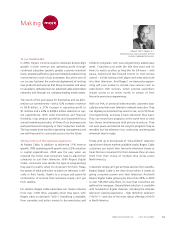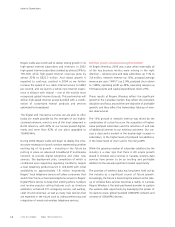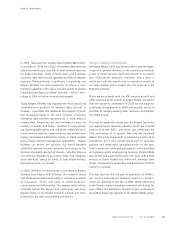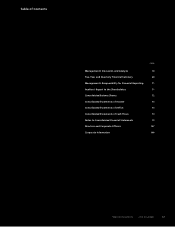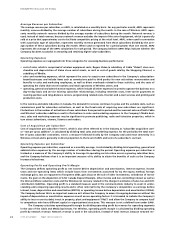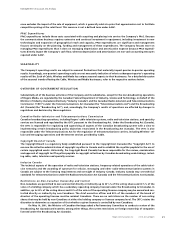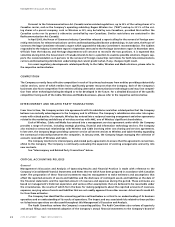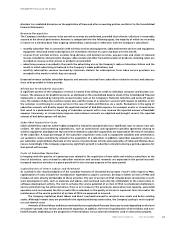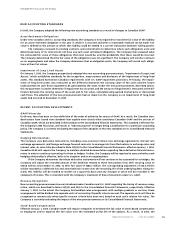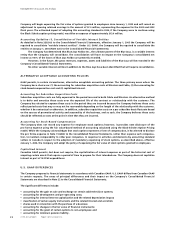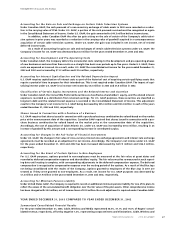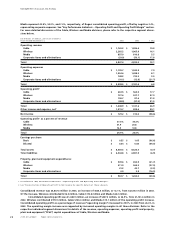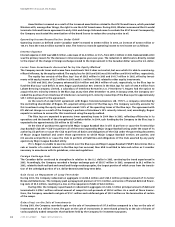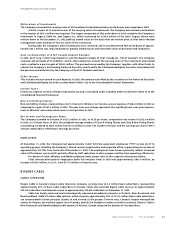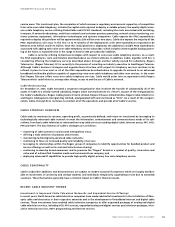Rogers 2003 Annual Report Download - page 25
Download and view the complete annual report
Please find page 25 of the 2003 Rogers annual report below. You can navigate through the pages in the report by either clicking on the pages listed below, or by using the keyword search tool below to find specific information within the annual report.
2003 Annual ReportRogers Communications Inc. 23
directors. For a detailed discussion on the application of these and other accounting policies, see Note 2 to the Consolidated
Financial Statements.
Revenue Recognition
The Company considers revenue to be earned as services are performed, provided that ultimate collection is reasonably
assured at the time of performance. Revenue is categorized into the following types, the majority of which are recurring
in nature on a monthly basis from ongoing relationships, contractual or otherwise, with the Company’s subscribers:
• monthly subscriber fees in connection with wireless services and equipment, cable and Internet services and equipment,
equipment rental and media subscriptions are recorded as revenue on a pro rata basis over the month;
• revenue from wireless airtime, wireless long-distance and optional services, pay-per-view and video on demand
movies, installation and activation charges, video rentals and other transactional sales of products, including retail, are
recorded as revenue as the services or products are provided;
• advertising revenue is recorded in the month the advertising airs on the Company’s radio or television stations and the
month in which advertising is featured in the Company’s media publications; and
• monthly subscription revenue received by television stations for subscriptions from video service providers are
recorded in the month in which they are earned.
Unearned revenue includes subscriber deposits and amounts received from subscribers related to services and subscrip-
tions to be provided in future periods.
Allowance for Doubtful Accounts
A significant portion of the Company’s revenue is earned from selling on credit to individual consumer and business cus-
tomers. The allowance for doubtful accounts, as disclosed on the consolidated balance sheet of the Consolidated Financial
Statements, is calculated by taking into account factors such as the Company’s historical collection and write-off experi-
ence, the number of days the customer is past due, and the status of a customer’s account with respect to whether or not
the customer is continuing to receive service in the case of Cable and Wireless. As a result, fluctuations in the aging of
subscriber accounts will directly impact the reported amount of bad debt expense. For example, events or circumstances
that result in a deterioration in the aging of subscriber accounts will in turn increase the reported amount of bad debt
expense. Conversely, as circumstances improve and customer accounts are adjusted and brought current, the reported
amount of bad debt expense will decline.
Subscriber Acquisition Costs
Cable and Wireless operate within highly-competitive industries and generally incur significant costs to attract new sub-
scribers. All sales and marketing expenditures, such as commissions and equipment subsidies (generally relating to
wireless equipment and digital set top converters) related to subscriber acquisitions are expensed at the time of activation
of the subscriber. A large percentage of the subscriber acquisition costs, such as equipment subsidies and commissions,
are variable in nature and directly related to the acquisition of a subscriber. In addition, subscriber acquisition costs on a
per subscriber acquired basis fluctuate on the success of promotional activity and seasonality of Cable and Wireless busi-
nesses. Accordingly if the Company experiences significant growth in subscriber activations during a period, expenses for
that period will increase.
Costs of Subscriber Retention
In keeping with the practice of expensing costs related to the acquisition of new cable and wireless subscribers at the
time of activation, costs related to subscriber retention and contract renewals are expensed in the period incurred.
Increased retention activities in a given period will in turn increase expense in the same period.
Capitalization of Direct Labour and Overhead
As outlined in the recommendations of the Canadian Institute of Chartered Accountants (“CICA”) with respect to PP&E,
capitalization of costs includes the consideration expended to acquire, construct, develop or better an item of PP&E and
includes all costs directly attributable to those activities. The cost of an item of PP&E includes direct construction or soft-
ware development costs, such as materials and labour, and overhead costs directly attributable to the construction or
software development activity. The cost to enhance the service potential of an item of PP&E is considered a betterment.
Service potential may be enhanced where there is an increase in the previously assessed service capacity, associated
operation costs are lowered, the life or useful life is extended, or the quality of service is improved. Costs incurred in the
maintenance of the service potential of an item of PP&E are expensed as incurred.
The Company capitalizes direct labour and direct overhead incurred to construct new assets and better existing
assets. Although interest costs are permitted to be capitalized during construction, the Company’s policy is not to capital-
ize such interest costs.
Amounts of direct labour and direct overhead that are capitalized fluctuate from year-to-year depending on the level
of customer growth, new services and network expansion. In addition, the level of capitalization of direct labour and over-
head fluctuates depending on the proportion of internal labour versus external contractors used in construction projects.
Management’s Discussion and Analysis


